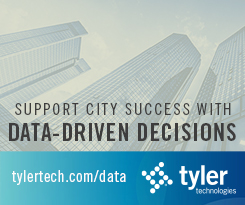
Photo: Sasinparaksa | Dreamstime.com
Data provides an ongoing health check for cities
24 November 2022
During the COVID-19 pandemic, cities saw first-hand the importance of data-sharing to track and communicate critical public health information. Now, they’re using what they learned and the infrastructure they developed to drive recovery and continuously monitor economic health.
“COVID recovery is now more about effectively leveraging federal funding to get cities not just back on their feet, but hopefully to a better place than they were before,” says Justin Bruce, Director of Client Success at Tyler Technologies.

Data is central to this and cities have new tools at their disposal.
“Most cities wanted to use data before the pandemic,” says Bruce. “But COVID was a huge catalyst because it forced the usage of data. No matter what kind of city, citizens demanded to know what was happening and to see data.”
Some were basic and others more advanced, but data dashboards became commonplace for information such as COVID case rates and, later, vaccination updates.
This period gave cities new confidence in sharing their data and residents became more comfortable with accessing and using it.
“Cities also became more sophisticated around data governance processes and practices,” says Bruce. “They have started to do more of this work in real-time and they have accelerated into the curve of continuing to use data to make vital decisions.”
Driving recovery
Bruce gives the example of Chattanooga in Tennessee, which launched a series of dashboards that track how the city is recovering economically from the impacts of COVID-19.
“They started looking at trends in how people are moving around by using third party mobility data and coupled that with information like tax and assessment data and permitting data that they had in their systems,” he says.
Chattanooga also incorporated real estate data as well as open source information such as from Google, which encouraged businesses to keep their profiles up to date on opening times, temporary closures, service delays, etc.
Bruce explains: “The city started to put all of these really interesting datasets together in a dashboard format that helps them understand the top categories of expenditures, how people are actually moving through the city, and whether or not the market for homeownership or rentals is stagnant.”
He adds: “One of the things that they’re doing to ‘normalise’ those indicators is comparing themselves to around 10 benchmark metropolitan areas that are similar.”
These insights help to direct action and enable the city to prioritise areas that are recovering more slowly.
As cities spend funding from the American Rescue Plan Act (ARPA) and apply for money from the Infrastructure Investment and Jobs Act (IIJA), it’s essential they deploy it where it’s needed most and will have the greatest long-term impact.
“Using data in this way, Chattanooga is able to have a more equitable response to the expenditure of dollars,” comments Bruce.
Of Chattanooga’s US$38.6 million in ARPA funding, US$30 million is being spent through a framework devised by the Equitable Recovery Commission. Key areas of focus include homelessness, affordable housing, workforce development, entrepreneurship, public safety and mental health support.
Cities to regions
Another trend spurred by the pandemic is greater regional data-sharing.
“I am seeing cities reach out to each other and build these really interesting networks,” Bruce says.
This collaborative approach can be especially effective to enable smaller cities to access more meaningful data at an aggregate level. Many of these initiatives started around COVID-related data but are now being expanded and scaled to tackle other shared challenges.
“There is a growing appetite for cities to have these regional connections that allow them to share data across their cities, but also get a much broader, developed and accurate picture of the metropolitan areas and regions that they all support,” Bruce says.
This could help municipalities address health and economic issues in the future, while also better positioning themselves for funding and investment in shared projects.
You can’t manage what you don’t measure – establishing the right metrics and breaking data out of silos is key. Learn more about how Tyler Technologies can help your city.












